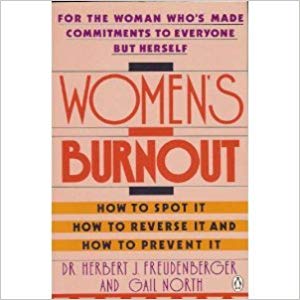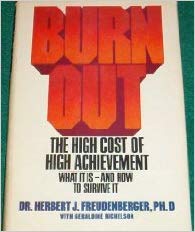Book Review-Stay: A History of Suicide and the Philosophies Against It

Book Review-Women’s Burnout: How to Spot It, How to Reverse It, and How to Prevent It
It might seem that I lack a fundamental characteristic that would make me able to use the information from Women’s Burnout: How to Spot It, How to Reverse It, and How to Prevent It; however, it’s a book that is most frequently referred to as a core book on burnout. It’s cited far more frequently than Freudenberger’s other book, Burn-out: The High Cost of High Achievement. That seems largely because, in Women’s Burnout, Freudenberger and North outline a 12-step continuum of burnout. In my continuing research of burnout, I had to make sure I read the classic.
Self-Awareness is Key
Very early in the book, the point is made that self-awareness is a critical step in battling burnout. The point is reiterated both subtly and directly as the book unfolds. The more clearly that you understand who you are, what you stand for, and where you’re going, the more clearly you can withstand the temptation to slip into burnout.
Of course, self-awareness is easy to say but difficult to achieve and perhaps more difficult to maintain. The more you become self-aware, the more you change – and thus the more you must consider who you are again.
Lies, Shame, Expectations, and Guilt
Much of the writing in Women’s Burnout speaks to the situational components that predispose women to patterns of thinking which aren’t helpful. The expectations are set up that a woman must be willing to deny their own feelings so that they can be charming – or entertaining, or pleasant, or whatever other words were used in their childhood. It’s not – generally – acceptable for a woman to have a voice. Changing social roles and perspectives are still in a state of flux, where the old Leave it to Beaver roles that many women’s mothers had are clashing with the expectations of today.
The unspoken message is that women today should be able to have everything. They should be able to keep a perfect home, a perfect marriage, and a perfect career. If they don’t, there is something wrong with them. After all, other people have it, what makes it so that I can’t? What is the flaw in me?
The lie is “if I could just work harder, or toughen myself up, it would all be working.” Of course, this isn’t a realistic or self-compassionate view. It’s built on shame and guilt. The chief concern when arriving at burnout isn’t how to be self-compassionate but is instead how to regain previous levels of productivity. If the voices are sending messages of shame and guilt — they will need to be altered to a more self-compassionate message.
Altered Thinking
When caught by the pull of burnout, we often find ourselves in denial. Denial isn’t all bad. It allows us the luxury of continuing to endure unreasonable pressures for the short term – but we can’t remain in denial forever. At some point, we need to accept reality; but until we do, denial has many tools:
- Suppression – Active denial of the information, whether conscious or not.
- Displacement – Feelings are transferred to another object, person, or situation.
- Humor – A sleight of hand designed to distract from a serious condition or situation
- Projection – Like displacement, there is a transference to another object, person or situation, but this time to shift the blame.
- Fantasy and Daydreaming – The invention of a reality that’s more interesting or preferable to distract us from the reality we actually live in.
- Selective Memory – Quickly sweeping ideas from consciousness and forgetting about them, so that they can’t be recalled.
- Lying – Both denying to our self and to others that the situation exists. (However, denying to ourselves wouldn’t be considered a lie by some – see Telling Lies.)
- Self-Labeling – Excusing behaviors as a part of your character – and minimizing them. “That’s just the way that I am” denies that there is a problem.
- Selective Incomprehension – “I don’t know what you mean that I’m not myself.” Here, you deny the problem by making it difficult for the person who is trying to gently confront you to articulate the problem in a way that you can both understand.
Stress
Stress is a useful adaption that allows animals to survive. However, the way that we as humans process stress is the source of many health problems today. (See Why Zebras Don’t Get Ulcers for more.) While some stress can be useful, we often hold on to stress too long. There are some events that will cause us stress that we cannot change. However, one thing that we can do is to keep from holding on to that stress. It’s one thing to have the stress, it’s quite another to keep experiencing it. Here are five ways that Freudenberger and North say that we extend stress:
- Backed-Up Anger – When we don’t allow ourselves to express our anger, we keep reliving it. Understanding that anger is disappointment directed (see Emotional Awareness) can help us release it and let it go. However, if your family didn’t accept any displays of emotion, this can be hard.
- Denied Hostility – Failure to accept hostilities of our past, our broken and bruised places, makes it hard to live as people unintentionally keep bumping into these raw places.
- Neglected Needs – When you don’t learn to tend to your own needs, you’re constantly feeling a “soul hunger” that keeps you from being whole.
- Guilt – Though the word used is “guilt,” I’d suggest that it’s closer to shame. When you don’t believe that you’re good, you’re in constant state of fear that you’ll be found out. On the guilt side, you’re constantly having to make difficult tradeoffs that make you feel pain.
- Low Self-Esteem – If you don’t think that you’re inherently valuable – or valuable enough – even small stresses linger as you wonder if they’re because of something you’ve done.
Reliving Family Dynamics
Imagine walking up to your new home and expecting the key that unlocks your parents’ home to unlock yours. On the surface, this seems silly. You wouldn’t expect that their key would open your lock. However, every day, we attempt to use the patterns we witnessed and experienced with them in our new relationships. The way that your family of origin worked is the way that you expect that your family will work today.
Each of us had a role to play in our family of origin, but those are not the roles that we should be playing – or should expect to be playing – today. Can you identify yourself in the following?
- Appeaser – Quieting arguments or flare ups
- Neutralizer – Anticipating and diverting trouble
- Referee – Mediating the rules of balance and fair play
- Caregiver – Providing sympathetic support for everyone
- Sparkler – Garnering attention to divert attention from other problems and issues
- Comedienne – Using humor to deflect confrontations, suspicions, and anger
- Troublemaker – Provoking passion to gain attention
- Leave-taker – Threatening a hasty exit to maintain control of the situation
- Quiet absorber – Remaining mute though this implied consent.
It turns out that we’re mostly reliving these roles in our adult lives – or at least we may be – and these roles can be unrealistic and can lead to burnout.
Stages of Burnout
According to Freudenberger and North, the 12 stages of burnout are:
- Compulsion to Prove
- Intensity
- Subtle Deprivations
- Dismissal of Conflict and Needs
- Distortion of Values
- Heightened Denial
- Disengagement
- Observable Behavior Changes
- Depersonalization
- Emptiness
- Depression
- Total Burnout Exhaustion
They’re careful to say that the stages aren’t a strictly linear sequence with people having to go through each state. However, it’s clear that there’s a perception that each stage is more critical than the previous. There’s a sense that the higher you are in the stages, the more critical your state is.
What Is Wrong with Me?
Sometimes when reading a book, you see a single phrase that captures something that the author has been trying to convey for pages. The message has been hinted at, teased, and walked around but never addressed directly.
Sometimes the thought is so present and at the same time hidden that, when it finally is crystalized, you want to palm your forehead and say, “Duh.” When I stumbled across a quote that said, “Sometimes, I wonder what is wrong with me?” I realized that this is a key feeling or perspective that is deeply felt by those in burnout. There’s an inner shame that they’re not able to live up to their expectations.
Whether the expectations are internally or externally driven, they’re, well, expected. As a result, when you don’t meet them, there must be something wrong with you. This feeling of shame (see Rising Strong) so permeates with the feeling of burnout that you forget that it’s there.
The key to addressing the problems of burnout may be self-awareness, but part of it is the awareness that it’s not that there’s something wrong with you. There’s nothing you need to add to be the person that you need to be.
Drugs
The topic of drugs was woven throughout Women’s Burnout. The use of uppers and downers – coke and marijuana – was in no way hidden. There were two very interesting comments that reveal the challenges with addiction. First, one woman began budgeting coke into her monthly budget, like paying the mortgage or her car payment. It wasn’t an optional thing any longer, it was a requirement to live. Second, most people use drugs to escape their lives. Drugs as a broad category allow people to escape something painful in their lives for a time. Women in burnout, it seems, use them differently. They use them to regain their vigor. (See Chasing the Scream for more on drugs and addiction.)
They look to feel more fully alive, to recapture some of what the burnout had taken from them – and, at the same time, get the energy to do the same things that caused burnout in the first place.
Women’s Burnout isn’t itself a drug, but it may just help you recapture some of what’s lost – though you likely won’t continue doing the things that lead to burnout in the first place. If you are or know someone who may be suffering from burnout, it’s a better solution than drugs.



